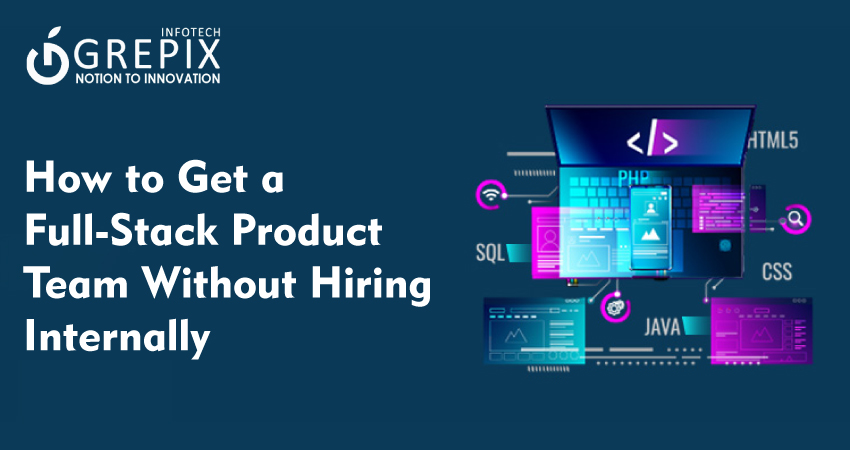How to Get a Full-Stack Product Team Without Hiring Internally
In today’s fast-paced digital economy, building a tech product is no longer a luxury; it’s a necessity. Whether you’re a startup founder, a mid-sized business owner, or a product manager at a global enterprise, the pressure to ship quality products fast is real. But what if you don’t have the time, money, or resources to hire an in-house full-stack product team?
Here’s the good news: you can get a full-stack product team without hiring internally. Yes, really. You can launch, scale, and even iterate on your product with top-tier talent without adding a single full-time employee to your payroll.
Let’s dive into how you can make this happen, step by step.
You don’t need to hire internally to build a great product. With the right approach, you can assemble a full-stack product team externally faster, cheaper, and smarter. From partnering with product development agencies to leveraging freelance networks or tapping into staff augmentation services, options are abundant. This blog walks you through each method, complete with real-world examples, tools, cost breakdowns, and tips for collaboration. Whether you’re a startup or a scaling enterprise, outsourcing your full-stack development needs could be the strategic advantage you need to hit the market with confidence and speed. Don’t let hiring bottlenecks stall your product vision. Build smarter.
What Is a Full-Stack Product Team Anyway?
Before we talk about the “how,” let’s clear up the “what.”
A full-stack product team is a cross-functional group that takes your product idea from concept to launch and beyond. Typically, this includes:
- Product Manager
- UX/UI Designer
- Frontend Developer
- Backend Developer
- QA Engineer
- DevOps Engineer
- Sometimes, a Data Analyst or Growth Marketer too
They’re called full-stack not just because they handle frontend and backend, but because they cover the entire stack of product development, from ideation to user feedback loops.
Why Not Just Hire Internally?
Great question. Hiring internal teams has its perks, long-term commitment, deeper integration with company culture, and direct control, but it also comes with downsides:
- It’s expensive. Hiring a full-stack developer or designer in countries like the U.S., Canada, or the U.K. can set you back $100K+ per year each.
- It’s slow. Recruitment, onboarding, and training take time. You could lose your competitive edge waiting for the right hires.
- It’s risky. If the market shifts or funding dries up, you’re stuck with fixed costs and contracts.
In short, if you want speed, flexibility, and access to global talent, building internally might not be your best bet.
The Alternative: Assemble a Full-Stack Product Team Externally
You don’t need to hire full-time to build a dream team. Here’s how to pull together a full-stack product squad externally smartly and efficiently.
1. Partner With a Product Development Agency
This is by far the most popular option for companies that want to launch fast without sacrificing quality. A product development agency offers ready-to-go teams that have worked together before, which reduces friction and boosts velocity.
What You Get:
- A vetted full-stack product team
- Project management and delivery oversight
- Fixed pricing or time-and-material models
- Quick onboarding
Real-World Example:
A Berlin-based startup launched its MVP in just 90 days by partnering with a full-stack development agency in Eastern Europe. Not only did they cut costs by 40%, but they also got access to deep tech expertise they couldn’t find locally.
👉 Want a shortlist of top-rated agencies? Clutch and GoodFirms are solid places to start.
2. Hire Freelancers, but Strategically
Freelancing platforms like Toptal, Upwork, and Fiverr Pro are treasure troves of talent. You can find full-stack developers, product managers, and designers from around the globe.
Tips for Success:
- Start with a project-based scope to test chemistry
- Use platforms with vetting systems (e.g., Toptal)
- Build a “pod” of freelancers who work well together
This method gives you flexibility but requires more project management on your side.
3. Explore Staff Augmentation Services
Staff augmentation is a middle ground between hiring and outsourcing. You borrow professionals from a service provider to temporarily extend your team.
This model is perfect if you already have part of a team in-house but need specific roles like a full-stack developer or QA tester for a few months.
Benefits:
- Quick access to niche skills
- Less onboarding hassle
- Scale up or down on demand
Global IT service companies like Turing, Andela, and Grepix Infotech offer staff augmentation with pre-vetted talent.
4. Try a Remote Product Squad-as-a-Service
This is a newer trend but a game-changer. Think of it as Netflix for product teams, you pay a monthly subscription and get access to an entire team.
Companies like MVP Factory, DevSquad, and Lemon.io are pioneering this model. It’s especially great for startups that want predictable costs and speed.
5. Tap Into Startup Incubators or Accelerators
Some startup accelerators (like Y Combinator, Techstars, or Antler) offer product development services as part of their portfolio support. If you’re part of a program, don’t overlook this hidden gem.
Key Questions to Ask Before Outsourcing
To avoid pitfalls, always ask:
- Have they built similar products before?
- What’s their process for full-stack development?
- What are the engagement models?
- Can I speak with past clients?
- What’s their policy on code ownership?
Being clear upfront saves a ton of back-and-forth later.
Red Flags to Watch Out For
Outsourcing isn’t perfect, and there are duds out there. Watch out for:
- Teams with no portfolio or references
- Over-promising timelines or budgets
- Communication gaps or timezone misalignment
- No access to source code or repositories
If it feels shady, it probably is.
How to Maintain Control Without Micromanaging
Even though you’re not hiring internally, you still need visibility. Here’s how to stay in the loop:
- Use agile tools like Trello, Jira, or ClickUp
- Schedule weekly or bi-weekly standups
- Request demo days every sprint
- Use shared docs for product specs and wireframes
Pro tip: Appoint a product owner on your side to be the bridge between your company and the external team.
Cost Breakdown: What to Expect
Depending on your model and geography, here’s a rough idea of what it might cost you:
| Team Model | Monthly Cost (USD) |
|---|---|
| Freelancers (3–5 roles) | $8,000 – $15,000 |
| Offshore Agency | $12,000 – $25,000 |
| Product Squad-as-a-Service | $7,000 – $20,000 |
| Local Agency (US/UK/EU) | $30,000 – $50,000+ |
Note: Prices vary wildly by region. Hiring in Southeast Asia or Eastern Europe is often more affordable without compromising quality.
Also Read: "Top 10 Business Ideas You Can Launch With Custom Software"
Tools That Make It Easier to Collaborate Remotely
To work smoothly with a distributed team, equip them with the right tools:
- Communication: Slack, Zoom, Loom
- Project Management: Jira, Asana, Trello
- Design: Figma, Adobe XD
- Development: GitHub, Bitbucket
- QA: BrowserStack, Postman, TestRail
Common Myths About Outsourcing Full-Stack Development
Let’s bust a few:
- “It’s always lower quality.” Not true if you pick the right partner.
- “You lose control.” You maintain control by setting clear expectations, milestones, and feedback cycles.
- “Only big companies can afford it.” Startups outsource all the time many unicorns started this way.
Success Story: From Idea to Product in 100 Days
A bootstrapped fintech startup from Nigeria used an outsourced team from India to build its mobile banking MVP. They didn’t have design, backend, or QA resources internally. Within 100 days, they launched in beta, onboarded 5,000 users, and got accepted into a global accelerator.
The kicker? The founder never met the team in person.
Final Thoughts: Is It Right for You?
If you're dreaming of launching a product but dreading the hiring slog, outsourcing your full-stack development team can be your golden ticket.
The key is to approach it like a partnership, not a transaction. Invest time upfront in finding the right team, setting expectations, and creating a collaborative workflow. The results? Faster time-to-market, lower costs, and less stress.
Conclusion
At Grepix Infotech, we understand that building a great product isn’t just about writing code it’s about solving real problems, delivering value, and getting to market fast. That’s why we offer end-to-end full-stack development services that take your idea from whiteboard to app store with speed, precision, and care.
Whether you’re a startup launching your MVP or an enterprise scaling your digital solutions, our experienced teams of full-stack developers, designers, product managers, and QA experts are ready to plug in and deliver. We bring years of industry expertise, agile development practices, and a global mindset to every project.
What sets Grepix apart is our commitment to quality, communication, and transparency. We act as a true partner keeping you informed, involved, and in control every step of the way. Plus, with flexible engagement models and cost-effective global delivery, we make it easier than ever to build your dream product without the hassle of hiring internally.
If you're ready to launch your next big idea, scale your operations, or simply build smarter, let's connect. With Grepix Infotech, you’re not just getting a team—you’re gaining a full-stack partner who’s as invested in your success as you are.
FAQs
1. What is a full-stack product team?
A full-stack product team includes developers, designers, product managers, and QA testers who handle every part of a product build.
2. Is outsourcing full-stack development reliable?
Yes, if you vet your partners properly and establish clear communication and expectations upfront.
3. What’s the difference between a freelancer and an agency?
Freelancers are individuals; agencies offer full teams with project management and delivery processes in place.
4. How much does it cost to outsource a product team?
Costs vary by region and model but typically range from $8,000 to $25,000 per month for a small-to-mid-sized team.
5. Do I still retain IP rights when outsourcing?
Yes, but make sure your contract includes clauses that give you full ownership of code and product IP.
Launch your vision with our mobile app development company, where innovation meets excellence to create cutting edge mobile solutions."







